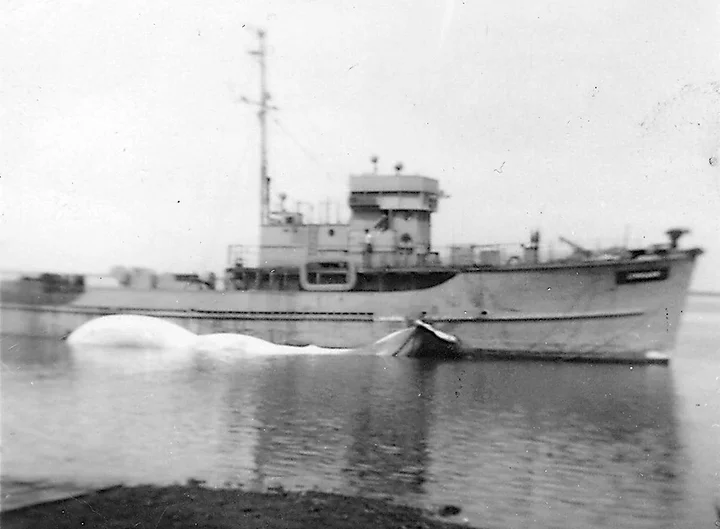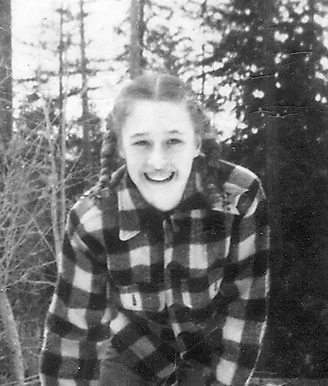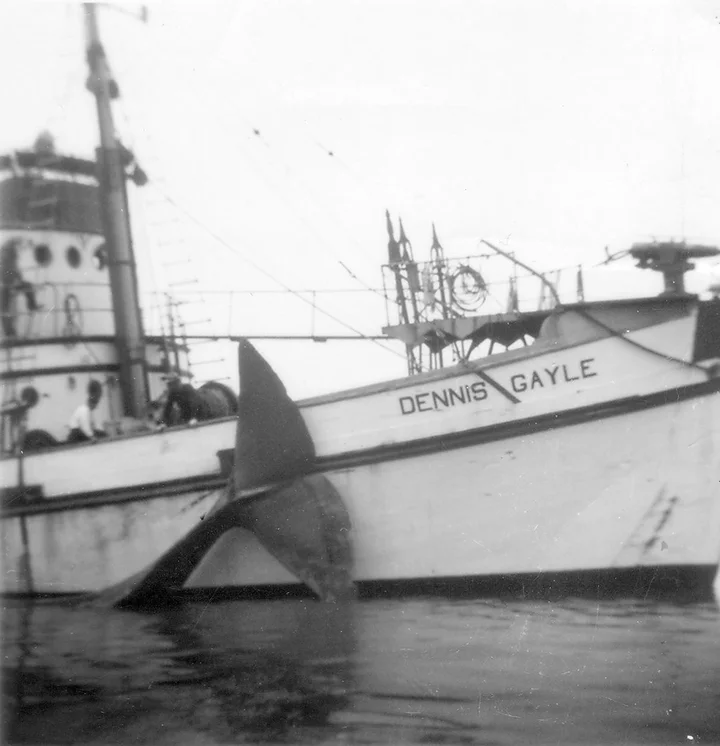Shirley Shoup went to sea on the Lynn Ann whaler. Photos courtesy Shirley Shoup, via the Humboldt Historian.
(As told to Pat Dunham.)
In May of 1947 I was living in Fields Landing with my mother and stepfather. I was a busy, happy twelve-year-old child.
We lived close to the whaling station, the only land-based whaling station in the United States at that time, located on the edge of the bay at the end of Railroad Avenue. My stepfather, Irish Miles, worked on the Lynn Ann whaling vessel. The Lynn Ann had been a navy patrol boat but was suitable for its current purpose. The other whaler at Fields Landing was the Dennis Gale. Both seemed to be of similar dimensions, but for reasons unknown to me, the Dennis Gale was more popular.
I was one of many who would run to the whaling station when the word reached the town that the whale boats were coming in with a catch. It was “something to see.” Just the size of this mammal is hard to comprehend when you are standing nearby. Seeing the teeth or the baleen, or the fin — all marvels seldom visible — suddenly made them part of one’s understanding, not just something from a book or a picture: This was something real, right before your eyes.
Crews of men, most of whom I was acquainted with, had to be summoned and at their stations to begin winching a whale’s huge body up the slip, inch by inch. Steel cables attached to powerful engines were stretched taut, able to snap loose at any moment. When cables broke, they flailed around like string in the wind. I don’t remember hard hats or protective gear, only corked boots and agile, alert men working in tandem to do their job.
The flensers cut long strips from the body with sharp blades attached to long poles. An engine-driven cable was attached to one end of a strip and pulled it away as the flensers cut. It required many hours and much labor to complete the dismantling process and clean the deck for the next whale. Oil and debris were everywhere. It must have been difficult for the workmen to maintain balance while wielding a blade, setting cable, moving meat to the boilers and maintaining vigilance against possible injury. Hoses were spraying water; the boilers were being fired; the noise was deafening. We visitors were allowed on the floor to view the whale before the cutting began, but because of the danger, we were never allowed on the floor after that.
One evening, overhearing Mother and Irish talking about an upcoming whaling excursion of four or five days, I listened intently. It was questionable if a whale might actually be harpooned on this trip; it could be that none would be spotted.
Suddenly, Irish turned to me and asked if I would like to go.
My excitement was unforgettable. “Yes, I would like to go!” I said.
Few, if any, other twelve-year-olds could take part in such an experience. Irish told me not to get too excited, as final permission would have to come from the captain and crew of the Lynn Ann.
It took some time, but eventually an agreement was made. I could go if Mother would accompany me. The thought of a few days at sea, in the safety of a secure ship and familiar crew, was like a dream fulfilled.
###
Packing only a camera, warm clothes and a sleeping bag, Mother and I boarded ship at six a.m. on a foggy, windy Wednesday morning. The crew had been aboard since the previous night. The Dennis Gale was already out to sea. We walked the narrow plank from the dock to the deck of the ship and were settled in by 7 a.m. Looking around, we saw ropes and cables strung at random across the deck. Mother told me that we had to be very careful as these were the tools of a working ship and we were, after all, here at our own risk. The rope “railing” encircling the ship didn’t offer much encouragement to linger there very long. There was nothing between me and the ocean waves below except this rope. Below deck, my bunk was a small wooden shelf which was very close to the galley. Food smells were strong and constant. (This bunk would turn out to be the place where I spent most of my time.) Soon the ship came alive and silently moved out of the harbor on Humboldt Bay, bound for the open sea.
A whaling vessel has to be narrower than other ships, a necessity during the chase of these large mammals, erratic in their final battle. It is doubtful that whales have many predators other than man. I am sure this is true of the magnificent, toothed sperm whale, one of the largest species, prized for its abundant precious oil. Mounted on the very tip of the bow on a slender flat platform is the instrument of the whale’s destruction, the harpoon. It appeared to be a long metal shaft about four feet long with a pointed front, anchored to a neatly wound chain which was more than 100 feet long.
The crew consisted of about nine men: the captain, gunner, gunner’s mate, and a cook. The rest of the crew were all mates, one of which was my stepfather, Irish Miles. The gunner’s name, as I recall, was Henry. These men were rugged in appearance, perhaps from many years at sea. All were dressed in similar apparel: a heavy black trench coat, blue jeans, knee boots, and black stocking caps, except for the gunner who wore full rain gear when manning the harpoon. I could see the captain in the wheelhouse and was reassured by this sight that “all was well.”
The water was calm that first sunny day. Porpoises followed closely alongside in our wake as we ventured further and further out to sea. They chattered, reveled, encouraged us to come play with them, and provided constant frolicsome companionship. They were a delight. I soon learned that we could be out seven days or longer, with the goal of capturing four whales!
Awakening the next morning, I began to realize that seasickness was to be my constant companion. The sea had become rough, throwing us about like a cork in a bathtub. I had been on a one-day excursion a month before this event, but the water was relatively calm and it had been an exhilarating experience. I was not prepared for my extreme seasickness on this trip. About all I could manage was to lie on my bunk and hope for the best. No one else seemed to be bothered and I hoped it would soon pass. It didn’t. I lay on my bunk most of the day as the ship cruised on toward its destination of “a sighting.” The crew was relaxed, repairing gear, talking, playing cards, enjoying the clear air of the open sea. I could see only sky and water by now.
On the afternoon of the third day, when we were 120 miles out from land, Mother called for me to come up on deck: the first whale was sighted! It was running through my mind that I couldn’t manage to make it up on deck, but also that this was the real reason I was here, to experience an unusual phenomenon. I had to get up, if I could. I made my way to the deck. The whole ship had come alive. The engines were revved and the pursuit begun in earnest, the crew preparing to harpoon our first whale. The excitement of the moment actually caused me to forget the hold seasickness had on me. The ocean was very rough with whitecaps and deep troughs. Looking out at the rolling sea, I remembered how many times during my seasickness I had wanted to just climb over the rail and disappear into the blackness.
With binoculars in hand, I could see the whale in the far distance. It was a sperm whale, seemingly alone, gracefully arching, dipping and showing a magnificent tail-fin, erect and proud. It would swim in this fashion for several seconds preceding a deep-water dive. Several minutes would then elapse before the whale re-emerged, far removed from the original sighting. It was moving at an unbelievably rapid pace and so were we. Seasickness was completely forgotten at this point.
It seemed hours later that we saw the gunner, Henry, appear suddenly out on the bow, disengaging the harpoon, making it ready for action. This instrument reminded me of a small cannon. The explosive charge is shot into the animal when it is close enough, but not too close. By this time the ocean was crashing on all sides of our boat. Strengthened by the speed of our vessel, waves and spray were engulfing the harpoon and gunner. Henry had firmly strapped himself to something I could not see, so that he would not be thrown overboard. I found it hard to believe he could stay at the gun while being constantly battered by the sea; much of the time he was not even visible to the rest of us. At this point, Henry was alone, separated from the rest of the crew, communication obliterated by the crashing water. I’m sure no one wished to change places with him at this time of danger.
When we drew close enough to see the seemingly insignificant brown eye of this huge mammal, Henry released the harpoon, aiming at the whale’s body while it was in an arching position just preceding a dive. A loud explosion sounded as the harpoon made contact with the whale. The engines were shut off and the “chase” begun. The captain steered to keep up with the whale’s maneuvers in this pursuit, but the gunner’s job was finished. We were tearing around, leaping and bounding all over that rough ocean, staying afloat as the cable was extended to its maximum length. The biggest danger was that the whale would dive deep and come up under the boat. Extreme vigilance was maintained to track the whale, keeping up with it until its exhaustion or death. This can go on for some time depending on the part of the body hit by the harpoon. That whale seemed to carry us all over the ocean before it died.
At the end of the chase, the whale was secured to the side of the boat and the search began for another.
###
In the next day and a half we harpooned two more whales. The only time I was not violently seasick was during the harpooning sessions. Unfortunately, I was on board for the duration, whatever that would be: we still had one more whale to kill.
I settled back into my bunk the best I could, moaning and groaning into a fitful sleep. The misery was almost unbearable. I remember mother giving me toast to eat, and saying “you have to keep something in your stomach.” That didn’t make sense to me, as I couldn’t keep anything down.
Suddenly there was a change. Something was different. “What is it?” I asked. Mother told me we were turning back. Turning back? Going home? Could this be true? Mother said it was true.
“What happened?” I said.
“The crew ran out of cigarettes!” Mother exclaimed.
Whatever the reason for it, this was what I needed to hear. We were still a hundred miles or more out to sea and had many more hours of tossing like a cork, but we were actually going home.
By the time we docked at Fields Landing, I had been out five days and four nights. We docked with three whales on the Lynn Ann, a respectable catch. One of my friends was waiting for me to disembark. She said I looked a little “green around the gills.” We weren’t laughing about it. It took a few days for my stomach to feel better and my strength to return.
While aboard the Lynn Ann, Shirley took this photo of the Dennis Gayle with a whale tied alongside.
I had taken a few pictures of the Dennis Gayle with a small Brownie camera while I was on the Lynn Ann. The harpoon stand, their whale, and the dimensions of the vessel are clearly visible.
For me, the trip had been unique in many ways. To have received permission from the captain, the crew and the owner of the Lynn Ann was a gift more remarkable than I realized.
My whaling expedition was the source of several reports during my high school years in Eureka. It didn’t seem that unusual then, but looking back, it certainly was something unique for a child of twelve.
As the years have gone by, I have always felt an element of sadness for these elegant creatures freely roaming the seas, meeting the fate we gave them, but that is the way it was at that time and place.
###
The story above is from the Summer 2007 issue of the Humboldt Historian, a journal of the Humboldt County Historical Society. It is reprinted here with permission. The Humboldt County Historical Society is a nonprofit organization devoted to archiving, preserving and sharing Humboldt County’s rich history. You can become a member and receive a year’s worth of new issues of The Humboldt Historian at this link.



CLICK TO MANAGE